| |
Hepatitis D (Delta) Course Review: Conference Reports: USA/Global Prevalence, Mortality-HCC Impact, PWIDs, Treatment, Screening, Patient Support
|
| |
| |
Hepatitis D, Delta at NATAP
• HDV infection occurs when people become infected with both hepatitis B and D simultaneously (co-infection) or get hepatitis D after first being infected with hepatitis B (super-infection).
Testing rates for hepatitis delta in chronic hepatitis B patients in the United States are inappropriately low. Approaches to increase testing for HDV particularly in high-risk subsets should be explored.
globally - Anti-HDV prevalence was higher in PWID (pooled OR 19.0) and in haemodialysis recipients (pooled OR 3.4).
Patients with cirrhosis or HCC had higher anti-HDV prevalence relative to comparator populations from the same geographic region in VA:
Most (59%) of HDV-positive patients were HCV co-infected.
HDV-positive subjects had higher risks of all-cause mortality. Incidence rates of HCC were 2.9 fold higher in HDV-positive relative to HDV-negative individuals (p = 0.002). In adjusted analyses, HDV was independently associated with HCC (OR 2.1, 95%CI 1.1-3.9).
AASLD: Prevalence and Characteristics of Hepatitis Delta in the United States: an Analysis of All-Payer Claims Databases - (11/17/21)
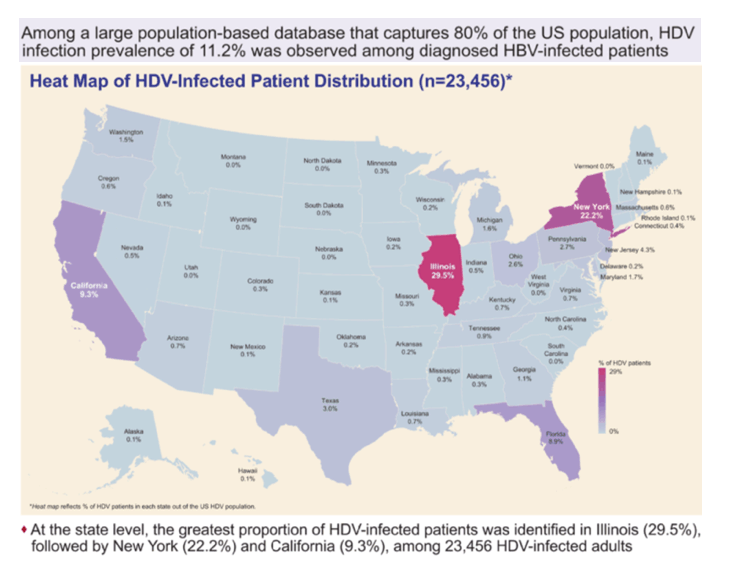
Heat Maps - PREVALENCE OF HEPATITIS DELTA VIRUS (HDV) INFECTION IN THE UNITED STATES: RESULTS FROM AN ICD-10 REVIEW - 25% of HDV in USA is In NYC (Bklyn, Bronx) & NYC Suburb - (06/06/22)
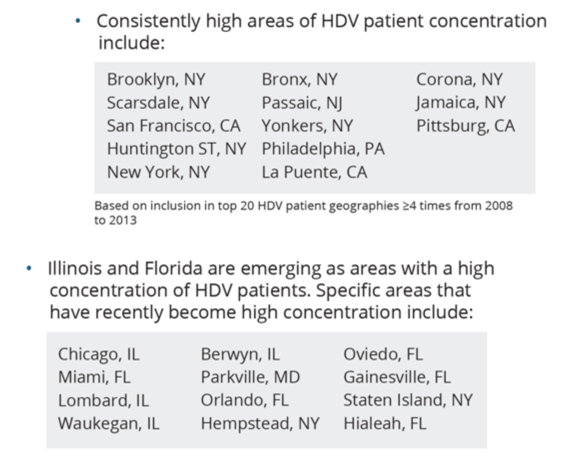
Association between Hepatitis Delta Virus with Liver Morbidity and Mortality: A Systematic Literature Review and Meta-Analysis - (06/25/22)
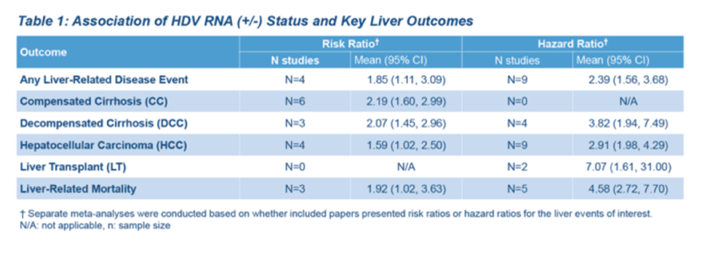
AASLD: HDV Patient Perspective: The Impact of Disease and Current Unmet Needs - (11/10/22)
HEPATITIS D INFECTION: who should be screened AASLD 2018 HBV Guidelines
• Hepatitis D virus (HDV) is a virus that requires hepatitis B virus (HBV) for its replication.
• Hepatitis D virus (HDV) affects globally nearly 5% of people who have a chronic infection with hepatitis B virus (HBV).
• HDV infection occurs when people become infected with both hepatitis B and D simultaneously (co-infection) or get hepatitis D after first being infected with hepatitis B (super-infection).
• Populations that are more likely to have HBV and HDV co-infection include indigenous populations, recipients of haemodialysis and people who inject drugs.
• Worldwide, the number of HDV infections has decreased since the 1980s, due mainly to a successful global HBV vaccination programme.
• The combination of HDV and HBV infection is considered the most severe form of chronic viral hepatitis due to more rapid progression towards liver-related death and hepatocellular carcinoma.
• Hepatitis D infection can be prevented by hepatitis B immunization, but treatment success rates are low.
https://www.who.int/news-room/fact-sheets/detail/hepatitis-d
AASLD Hep B 2018 Gudelines
The recommended screening test is anti-HDV, and if this test result is positive, it should be followed by HDV-RNA testing to diagnose active HDV infection. Assess fibrosis. The only approved treatment of chronic hepatitis D is interferon alfa (IFN-a). Peg-IFN is the drug of choice without clear differences in efficacy between pegylated interferon alfa (peg-IFN-a)22a (180 mg weekly) or 22b (1.5 mg/kg weekly). (152)
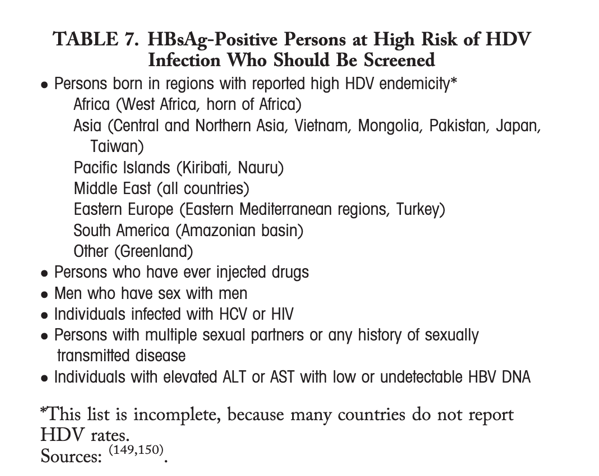
PREVALENCE OF HEPATITIS DELTA VIRUS (HDV) INFECTION IN THE UNITED STATES: RESULTS FROM AN ICD-10 REVIEW - 25% of HDV in USA is In NYC (Bklyn, Bronx) & NYC Suburb - (06/06/22)
AASLD: Hepatitis D-Associated Hospitalizations in the United States: 2010-2018 - (11/19/21)
AASLD: Estimating Hepatitis Delta Prevalence Among High-Risk Populations (HIV, MSM, PWID) in the United States: A Systematic Review - (11/09/22)
Healthcare Resource Utilization and Costs of Hepatitis Delta in the United States: An Analysis of All-Payer Claims Database - (07/02/22)
Hepatitis Delta Management in the United States: An Analysis Of All-Payer Claims Database - (07/02/22)
Evaluating Hepatitis Delta Virus Disease Prevalence and Patient Characteristics Among Adults in the United States: An Analysis of All-Payer Claims Database - (06/25/22)
•
• AASLD: Hep D Rate 9% in Tested California Safety-Net Group (immigrants, ethnic minorities) With HBV - (11/09/22)
AASLD: The Delta Delta: Gaps in Screening Patterns, Patient Assessment and Clinical Outcomes in Hepatitis D Virus Infection - (11/09/22)
AASLD: Population adjusted prevalence of hepatitis delta virus in 16 countries (11/04/22)
HDV/HBV+ Immigrants in USA - (10/03/22)
HDV Prevalence in USA - (10/03/22)
High HDV rates Among PWID - (09/29/22)
ID Week: Hepatitis D Virus and Hepatitis B Virus Epidemiology in Utah - (10/24/22)
Hepatitis D Changing Context Global Prevalence - (02/10/22)
Anti-HDV prevalence was higher in PWID (pooled OR 19.0) and in haemodialysis recipients (pooled OR 3.4).
Patients with cirrhosis or HCC had higher anti-HDV prevalence relative to comparator populations from the same geographic region in VA: Most (59%) of HDV-positive patients were HCV co-infected. HDV-positive subjects had higher risks of all-cause mortality. Incidence rates of HCC were 2.9 fold higher in HDV-positive relative to HDV-negative individuals (p = 0.002). In adjusted analyses, HDV was independently associated with HCC (OR 2.1, 95%CI 1.1-3.9).
Conclusions
Testing rates for hepatitis delta in chronic hepatitis B patients in the United States are inappropriately low. Approaches to increase testing for HDV particularly in high-risk subsets should be explored.
Globally, chronic infection with the HBV is an important cause of liver-related morbidity and mortality due to its widespread distribution. An estimated 257 to 291 million people are chronically infected with HBV and are at risk of cirrhosis and hepatocellular carcinoma (HCC).1,2 The proportion of cirrhosis attributable to HBV varies geographically according to HBV epidemiology, ranging from 6% in North America, to 6-21% in Latin America, 34–38% in sub-Saharan Africa, and 39% in East Asia. 3 Worldwide, HBV is associated with a third of deaths from HCC. 4 HDV is a satellite RNA virus that depends on HBV for propagation. 5 It uses the HBsAg as a viral envelope and shares the same hepatocyte receptor for viral entry.6 HDV is among the smallest of viruses capable of causing human disease, yet HBV co-infection with HDV is the most severe form of viral hepatitis. 5 HDV transmission follows 2 patterns. Infection occurring simultaneously with HBV can cause extensive hepatic necrosis and manifest as a severe or even fulminant hepatitis with a high case fatality rate. 6 With recovery, simultaneous infection in adults usually results in clearance of both viruses. 5 Superinfection of persons with chronic HBV infection typically results in HDV persistence, leading to accelerated progression to cirrhosis and an increased risk of HCC relative to chronic HBV infection alone. 7 Due to variation in awareness and incomplete testing among HBsAg-positive people, 8 issues with standardisation of confirmatory molecular diagnostic techniques, 9 and a historical lack of effective treatment options,10 HDV ascertainment has been suboptimal, even in high-income settings.
TREATMENT
Buleviritide
Treatment With Hepcludex® (Bulevirtide) Meets Primary Endpoint and Achieves Significant Response in Chronic Hepatitis Delta Virus at 48 Weeks EASL 2022- (12/29/22)
EASL: Bulevirtide Monotherapy at Low and High Doses in Patients With Chronic Hepatitis Delta: 24-Week Interim Data of the Phase 3 MYR301 Study - (06/24/21) Bulevirtide With or Without PEG-IFN
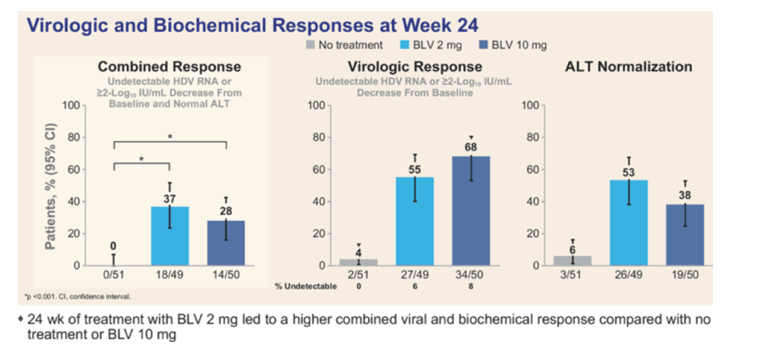
EASL: Integrated Safety Analysis of 24-Week Data From Three Phase 2 and One Phase 3 Clinical Trial of Bulevirtide Monotherapy Given at 2- or 10-mg Dose Level for Treatment of Chronic Hepatitis Delta - (07/02/22)
Gilead Submits Biologics License Application to U.S. Food and Drug Administration for Bulevirtide, an Investigational Treatment for People Living With Chronic Hepatitis Delta - (12/10/21)
Gilead Receives Complete Response Letter from U.S. FDA for Bulevirtide for the Treatment of Adults with Hepatitis Delta Virus - (10/29/22)
Bulevirtide monotherapy for 48 weeks in patients with HDV-related compensated cirrhosis and clinically significant portal hypertension - (12/12/22)
AASLD: Bulevirtide Improves Health-Related Quality of Life Measured by EQ-5D VAS in Patients With Chronic Hepatitis Delta: An Exploratory Analysis of a Phase 3 Trial at 48 Weeks - (11/15/22)
AASLD: Treatment with Bulevirtide, with or without PEG-interferon, in HDV infected patients in a real-life setting. Two-year results from the French multicenter early access program - (11/14/22)
AASLD:Extension of Bulevirtide Monotherapy to 72 Weeks in HDV Patients with Compensated Cirrhosis: Efficacy and Safety From the Italian Multicenter Study (HEP4Di) Interim Analysis - (11/11/22)
AASLD: Bulevirtide Monotherapy Is Safe and Well Tolerated in Patients With Chronic Hepatitis D (CHD): An Integrated Safety Analysis of 48-Week Data - (11/09/22)
EASL: No Detectable Resistance to Bulevirtide in Participants With Chronic Hepatitis D Through 24 Weeks of Treatment - (06/25/22)
AASLD: HDV Patient Perspective: The Impact of Disease and Current Unmet Needs - (11/10/22)
AASLD: CURE OF HEPATITIS DELTA INFECTION FOLLOWING 3 YEARS OF BULEVIRTIDE MONOTHERAPY IN A PATIENT WITH COMPENSATED ADVANCED CIRRHOSIS - (11/08/22)
HBV Meeting Paris: Strong decline of intrahepatic HDV markers and signs of liver inflammation after 48 weeks of treatment with Bulevirtide in chronic hepatitis D patients: Combined intrahepatic results from the clinical trials MYR203 and MYR301 - (09/26/22)
REP-2139
AASLD: Compassionate use of subcutaneously administered REP 2139-Mg in cirrhotic HBV / HDV co-infection - (11/14/22)
Persistent Control of Hepatitis B Virus and Hepatitis Delta Virus Infection Following REP 2139-Ca and Pegylated Interferon Therapy in Chronic Hepatitis B Virus/Hepatitis Delta Virus Coinfection - (06/08/22)
Safety and efficacy of REP 2139 and pegylated interferon alfa-2a for treatment-naive patients with chronic hepatitis B virus and hepatitis D virus co-infection (REP 301 and REP 301-LTF): a non-randomised, open-label, phase 2 trial - (06/07/22)
Lonafarnib/r
About the Phase 3 D-LIVR Study: oral Lonagarnib/rtv +/- Peg-Lambda 48 weeks - (06/13/22)
A Phase 2 Study of Lonafarnib, Ritonavir & Peginterferon Lambda for 24 Weeks: Interim End-of-Treatment Results from the LIFT HDV Study - (05/31/22)
Treatment for hepatitis delta virus with the prenylation inhibitor lonafarnib: It's getting closer Editorial - (05/31/22)
Optimizing lonafarnib treatment for the management of chronic delta hepatitis: The LOWR HDV-1 study - (05/31/22)
EASL: Peginterferon Lambda (IFN-λ) combined with Lonafarnib diminished triphasic HDV kinetic pattern seen under IFN-λ monotherapy: The LIFT-1 Study - (06/27/22)
Lonafarnib-A new member of the Delta Force? Editorial - (05/27/22)
A phase 2 dose-finding study of lonafarnib and ritonavir with or without interferon alpha for chronic delta hepatitis - (05/27/22)
Eiger BioPharmaceuticals Announces Complete Enrollment of D-LIVR, the Largest Phase 3 Study in Hepatitis Delta Virus (HDV), Investigating Lonafarnib, the Only Oral Agent in Development for HDV - (05/27/22)
Peginterferon
Durable virological response and functional cure of chronic hepatitis D after long-term peginterferon therapy - treatment duration 8-14 years - (12/29/22)
|
|
| |
| |
|
|
|